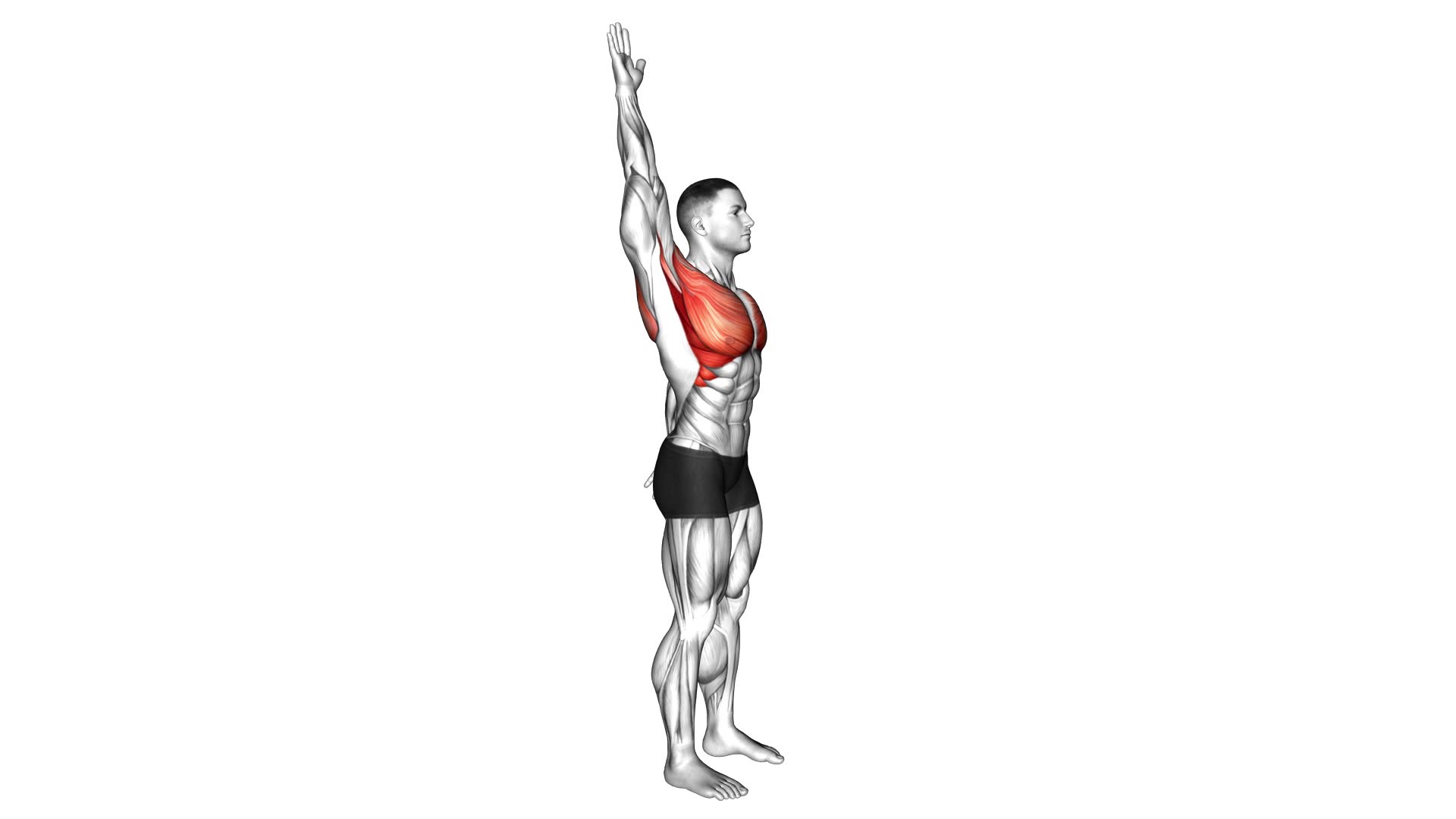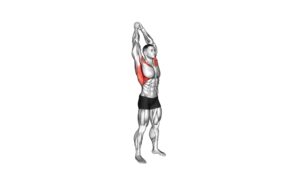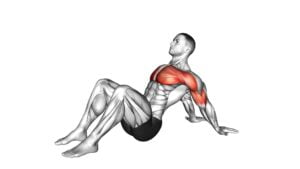Standing Overhead Shoulder Stretch (VERSION 2) – Video Exercise Guide & Tips

Are you looking for a quick and effective way to stretch your shoulders? Look no further than the standing overhead shoulder stretch (version 2).
Watch This Exercise Video
This exercise targets your shoulder muscles, helping to improve flexibility and reduce tension. In this video exercise guide, we'll show you the proper form and technique, common mistakes to avoid, and even some modifications and progressions.
Get ready to maximize your stretch and incorporate this exercise into your routine for optimal results. Let's get started!
Key Takeaways
- The standing overhead shoulder stretch improves flexibility in shoulder muscles and increases range of motion.
- It helps reduce tension and tightness in the shoulders, promoting better mobility and preventing stiffness or discomfort.
- Proper form and technique include standing with feet hip-width apart, raising the arm overhead, bending the elbow, and reaching the hand towards the opposite shoulder blade.
- To avoid mistakes and injuries, it is important to only stretch as far as is comfortable, maintain proper form, warm up muscles before stretching, and gradually increase intensity over time.
Benefits of the Standing Overhead Shoulder Stretch
To understand the benefits of the Standing Overhead Shoulder Stretch, you should know that it can help improve flexibility and relieve tension in your shoulder muscles. This stretch is an effective way to increase the range of motion in your shoulders and promote better mobility. By regularly incorporating this exercise into your routine, you can enhance your overall flexibility and prevent stiffness and tightness in your shoulders.
One of the main benefits of the Standing Overhead Shoulder Stretch is its ability to improve flexibility. As you perform this stretch, you're actively stretching the muscles in your shoulders, allowing them to lengthen and become more supple. This can help increase your range of motion and make everyday movements easier and more comfortable.
Additionally, this stretch can also relieve tension in your shoulder muscles. Many people experience tightness and discomfort in their shoulders due to factors such as poor posture or repetitive movements. The Standing Overhead Shoulder Stretch can help alleviate this tension by stretching and elongating the muscles, promoting relaxation and reducing stiffness.
In the next section, we'll discuss proper form and technique for performing the Standing Overhead Shoulder Stretch, ensuring that you get the most out of this beneficial exercise.
Proper Form and Technique
Start by standing with your feet hip-width apart. When performing the standing overhead shoulder stretch, it's important to maintain proper form and technique to ensure maximum effectiveness and minimize the risk of injury.
To begin, raise your right arm overhead, keeping it straight and parallel to your body. Then, bend your elbow and reach your hand towards the opposite shoulder blade. Gently grasp your right elbow with your left hand, applying slight pressure to deepen the stretch. Hold this position for 20-30 seconds, focusing on breathing deeply and relaxing your shoulder muscles.
One common misconception about this stretch is that you should force your arm to touch the opposite shoulder blade. However, it's important to only stretch as far as is comfortable for you. Pushing too far can strain the muscles and potentially lead to injury. If you find this stretch difficult or uncomfortable, there are alternative stretches you can try.
For example, the wall stretch involves standing facing a wall, placing your hand on the wall at shoulder height, and gently leaning forward to stretch your shoulder.
Common Mistakes to Avoid
When performing the standing overhead shoulder stretch, it's crucial to maintain proper form to avoid potential injuries.
Excessive tension should be avoided to prevent strain on the muscles and joints.
Proper Form Importance
To ensure proper form and avoid common mistakes, you should focus on the correct positioning and movement during the standing overhead shoulder stretch. This exercise is crucial for improving shoulder mobility and reaping the benefits of stretching.
Here are some important points to keep in mind:
- Stand with your feet shoulder-width apart, maintaining good posture.
- Raise one arm overhead, keeping it straight and parallel to your head.
- Slowly lean your torso to the opposite side, feeling a gentle stretch in your shoulder.
Proper form is essential to prevent injury and maximize the effectiveness of the stretch. By maintaining the correct positioning and movement, you can safely enhance your shoulder mobility and experience the full benefits of stretching.
Avoiding Excessive Tension
To avoid excessive tension and maximize the effectiveness of the standing overhead shoulder stretch, focus on maintaining proper form and avoiding common mistakes.
Proper form is crucial to prevent overloading the shoulder joint and causing unnecessary strain. One common mistake to avoid is shrugging your shoulders up towards your ears during the stretch, as this can create tension in the neck and upper traps. Instead, keep your shoulders relaxed and down, allowing the stretch to target the intended muscles.
Another mistake is using excessive force or pulling too hard, which can lead to injury. Remember to stretch within your comfort zone and avoid any sharp or intense pain.
Injury Prevention Techniques
To prevent injury and maximize the effectiveness of the standing overhead shoulder stretch, it's important for you to focus on avoiding common mistakes and implementing injury prevention techniques. Here are some key techniques to keep in mind:
- Warm up exercises: Prior to performing the standing overhead shoulder stretch, it's crucial to warm up your muscles and increase blood flow. This helps to reduce the risk of injury and prepares your body for the stretch.
- Maintain proper form: Incorrect form during the stretch can put unnecessary strain on your shoulders and lead to injuries. Make sure to keep your spine straight, engage your core, and avoid overarching or hunching your back.
- Gradual progression: Start with a light stretch and gradually increase the intensity over time. This allows your muscles to adapt and reduces the risk of overstretching or straining them.
Modifications and Progressions
For modifications and progressions of the Standing Overhead Shoulder Stretch (VERSION 2), simply adjust the position or resistance to challenge yourself further. There are various ways to modify this exercise and take it to the next level.
One modification you can try is increasing the resistance by using a resistance band or weights. By incorporating these additional elements, you'll add intensity to the stretch and engage your muscles even more.
Another modification is to change your hand position. Instead of keeping your hands shoulder-width apart, you can bring them closer together or wider apart to target different areas of your shoulders and upper back.
Additionally, you can experiment with different angles. For example, instead of standing straight, you can try performing the stretch while standing on an incline or decline surface. This will challenge your balance and stability, while also targeting different muscle groups.
Lastly, for those looking for advanced variations, you can try performing the stretch on one leg, which will further challenge your core muscles and overall stability. Remember to always listen to your body and only progress to more advanced variations when you feel ready.
Tips for Maximizing the Stretch
To maximize the stretch during the Standing Overhead Shoulder Stretch (VERSION 2), focus on maintaining proper form and gradually increasing the intensity. Here are some tips to help you maximize flexibility and get the most out of this stretching exercise:
- Keep your feet shoulder-width apart and your knees slightly bent. This will provide a stable base and allow you to focus on the stretch in your shoulders.
- Engage your core muscles by pulling your belly button towards your spine. This will help stabilize your body and allow for a deeper stretch.
- Gradually increase the intensity of the stretch by reaching further overhead with each repetition. Start with a comfortable range of motion and slowly progress as your flexibility improves.
By following these tips, you can effectively target the muscles in your shoulders and maximize the benefits of this stretch. Remember to listen to your body and never push yourself to the point of pain.
Consistency and proper form are key when it comes to stretching techniques. Incorporate this exercise into your routine regularly to improve flexibility and maintain healthy shoulders.
Incorporating the Exercise Into Your Routine
To incorporate the exercise into your routine, you can start by performing the Standing Overhead Shoulder Stretch (VERSION 2) two to three times a week. This exercise is a great way to improve flexibility and mobility in your shoulders, and it can be easily modified to suit your needs.
To begin, stand with your feet shoulder-width apart and extend your arms straight up overhead. Interlace your fingers and turn your palms up towards the ceiling. Take a deep breath in, and as you exhale, gently press your arms back behind your head, feeling a stretch in your shoulders and chest. Hold this position for 20-30 seconds, breathing deeply and relaxing into the stretch.
If you want to incorporate modifications into your routine, you can try using a towel or strap to assist with the stretch. Simply hold onto the ends of the towel or strap and perform the same movement as before. This can help to deepen the stretch and target different areas of your shoulders.
Frequently Asked Questions
How Often Should I Perform the Standing Overhead Shoulder Stretch?
To improve your shoulder mobility, it's important to incorporate regular stretching exercises into your routine. One exercise that can help is the standing overhead shoulder stretch. This stretch is effective in increasing flexibility and range of motion in your shoulders. By performing this stretch regularly, you can experience the benefits of improved shoulder function and reduced risk of injury. However, it's essential to consult with a fitness professional to determine the appropriate frequency for your specific needs and goals.
Can I Perform This Stretch if I Have an Existing Shoulder Injury?
Before attempting the standing overhead shoulder stretch, it's important to consider any existing shoulder injuries. Consulting a doctor is recommended to ensure that this exercise is safe for you.
Modifications can be made to accommodate those with shoulder injuries, such as reducing the range of motion or using lighter weights.
It's crucial to prioritize your safety and well-being when performing any exercise, especially if you have an existing injury.
Is It Necessary to Warm up Before Doing the Standing Overhead Shoulder Stretch?
Before performing the standing overhead shoulder stretch, it's necessary to warm up to prevent injury and maximize the benefits. A proper warm up increases blood flow, loosens up muscles, and prepares your body for the stretch.
It's important to note that there are different variations of the standing overhead shoulder stretch, so choose the one that suits your needs and abilities. Remember to listen to your body and stop if you feel any pain or discomfort.
Can This Stretch Help Improve My Posture?
Stretching is a great way to improve your posture. By incorporating stretching into your daily routine, you can increase your flexibility and loosen up tight muscles. This can help alleviate any tension or imbalances that may be causing poor posture.
Additionally, stretching can promote better body awareness and alignment, making it easier to maintain good posture throughout the day. So, adding this stretch to your routine can be beneficial for your posture and overall physical well-being.
Are There Any Alternative Stretches That Target the Same Muscles as the Standing Overhead Shoulder Stretch?
There are several alternative stretches that target the same muscles as the standing overhead shoulder stretch. These stretches include the doorway stretch, cross-body stretch, and the shoulder blade squeeze.
Incorporating these alternative stretches into your routine can help improve shoulder mobility and flexibility. Stretching the shoulder muscles regularly also has several benefits for shoulder health, such as reducing the risk of injury and improving posture.
Conclusion
Incorporating the standing overhead shoulder stretch into your routine can help improve shoulder flexibility and reduce muscle tension. By following proper form and technique, avoiding common mistakes, and incorporating modifications and progressions as needed, you can maximize the benefits of this exercise.
Remember to consult with a healthcare professional before starting any new exercise routine, especially if you have any pre-existing shoulder conditions or injuries.

Author
Years ago, the spark of my life’s passion ignited in my mind the moment I stepped into the local gym for the first time. The inaugural bead of perspiration, the initial endeavor, the very first surge of endorphins, and a sense of pride that washed over me post-workout marked the beginning of my deep-seated interest in strength sports, fitness, and sports nutrition. This very curiosity blossomed rapidly into a profound fascination, propelling me to earn a Master’s degree in Physical Education from the Academy of Physical Education in Krakow, followed by a Sports Manager diploma from the Jagiellonian University. My journey of growth led me to gain more specialized qualifications, such as being a certified personal trainer with a focus on sports dietetics, a lifeguard, and an instructor for wellness and corrective gymnastics. Theoretical knowledge paired seamlessly with practical experience, reinforcing my belief that the transformation of individuals under my guidance was also a reflection of my personal growth. This belief holds true even today. Each day, I strive to push the boundaries and explore new realms. These realms gently elevate me to greater heights. The unique combination of passion for my field and the continuous quest for growth fuels my drive to break new ground.







